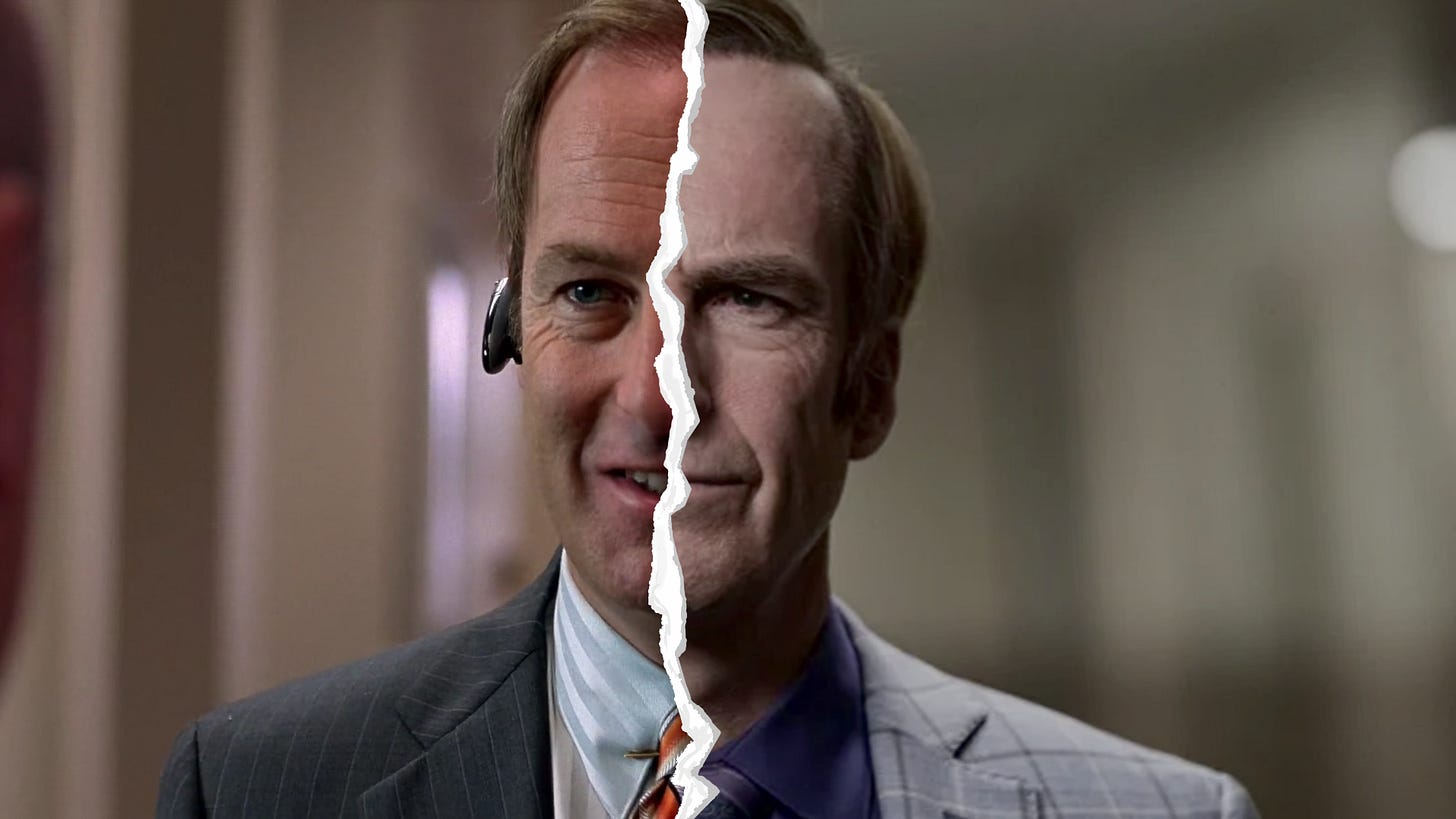
Better Call Saul was a staggeringly ambitious prequel, exceeding the total length of the original Breaking Bad. This sweeping scale, together with the chronological proximity between the last season of Better Call Saul (set mostly in 2004) and the beginning of Breaking Bad (2008), created some visible age discrepancies between actors and their characters. Here, I will argue that, far from being a regrettable plot-hole, this tension meaningfully contributes to the experience of watching the show and expands the interpretive possibilities for those wishing to explore them.
Before diving in, I should acknowledge that I am far from first to come to the defense of the showrunners’ decision not to de-age the Better Call Saul performers. George Lawley at Screen Rant and Matthew Mosley at Collider both point out the financial and logistical problems with such CGI age-altering, as well as the very real risks of interfering with the actors’ facial features in a show which thrives on subtle and authentic character-based storytelling. As for the creators themselves, co-executive producer Thomas Schnauz has offered a simple dictum: “it’s not something you can worry too much about. It is what it is. We’re telling a story…” This attitude is quite correct; the creative and financial energy that would have been spent on de-aging was absolutely put to better use in telling a good story. However, the characters’ visible age is still a part of the experience of viewing Better Call Saul, and exploring its effects is my mission today.
Describing this age-discrepancy as a ‘continuity error,’ is the shallowest analysis possible, but we can begin by taking apart the assumptions baked into that label. ‘Continuity’ in fiction is the illusion that the events portrayed really took place in the order we are told they did. The point of this illusion is, ultimately, to convince us that the distinct elements cohere into a world. Generally, there is not much utility in breaking that immersion, but these two shows are an exceptional case. Better Call Saul does take place in the same fictional world as Breaking Bad, but it is not more of the same. That certain characters look older than they “should” functioned for me as a subtle signal to expect a different show with a different mission.
Of course, trying to tell a genuinely new story within an existing fiction is the kind of thing that brings foam to the mouth of a certain kind of fan (cf. The Last Jedi), and it’s no coincidence that this same type of fandom culture considers poring over texts for continuity errors to be worthwhile. Of course, fandom usually has some justification for its hostility to new ideas, and in this case, it was that Better Call Saul was too boring. (I found it scarcely believable that people actually held this opinion, but there are plenty of reddit threads and YouTube videos which attest.) While this is a ridiculous claim, it is not hard to see where it comes from when thinking from the perspective of the Breaking Bad fanatic. The criminal schemes of Better Call Saul take longer to play out and usually involve less violence and spectacle. This slower pace leaves room for the character drama which is, for me, the central appeal of both shows.
The nature of Better Call Saul as a slow-burning drama, in contrast with its predecessor, is a central reason I find the characters’ older appearance to be appropriate, especially when it comes to the dual protagonists, Jimmy McGill/Saul Goodman and Mike Ehrmantraut. Both were fan-favorites in Breaking Bad, but were not especially complex characters, particularly Saul. In fact, Bob Odenkirk has described his performance in Breaking Bad as almost like a sketch comedy part.1 In Better Call Saul, both the actors and writers have been living with the character for a while, and this familiarity comes across in the astounding depth and believability of the back-stories we get to witness. And this is the poetry of the age-discrepancy. There is a sense in which the characters themselves are older too. Having existed for longer in the minds of their creators, they have had a chance to grow more complex.
I’m reminded of an image from Catullus:
This tapestry, embroidered with the ancient figures of men…
Catullus 64.50
While we might hear “ancient figures of men” as slightly less natural than “figures of ancient men,” the difference is important; the portrayals of these men are ancient. A newer portrayal—a new tapestry depicting these same heroes—will be more aware of their history as heroes and build on that knowledge, even if they are shown as younger.
Of course, the decision not to de-age the cast of Better Call Saul was not some grand poetic gesture. Thomas Schnauz’s view that “we’re telling a story/it is what it is” remains true. However, the older faces remain on the screen as a quiet signifier of the time both the actors and writers have spent living with these characters, which has granted them the intimate familiarity necessary to produce such breathtaking drama.
I have not been able to dig up the interview clip where I first heard Bob say this. I will do some more digging over the next few days and add a comment with the source as soon as I can.




